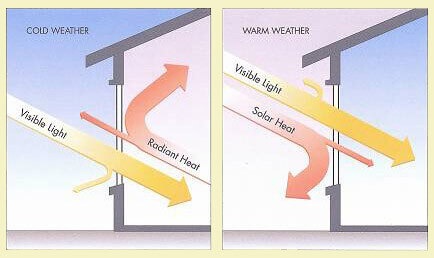Low-emittance (low-E) coatings are microscopically thin, virtually invisible, metal or metallic oxide layers deposited on a window or skylight glazing surface primarily to reduce the U-factor by suppressing radiative heat flow. The principal mechanism of heat transfer in multilayer glazing is thermal radiation from a warm pane of glass to a cooler pane. Coating a glass surface with a low-emittance material and facing that coating into the gap between the glass layers blocks a significant amount of this radiant heat transfer, thus lowering the total heat flow through the window. Low-E coatings are transparent to visible light. Different types of low-E coatings have been designed to allow for high solar gain, moderate solar gain, or low solar gain.
In heating-dominated climates with a modest amount of cooling or climates where both heating and cooling are required, low-E coatings with high-, moderate- or low-solar-gains may result in similar annual energy costs depending on the house design and operation. While higher solar-gain glazings perform better in winter, lower solar-gain glazings perform better in summer. In cooling-dominated climates, the priority is to lower solar gains.

